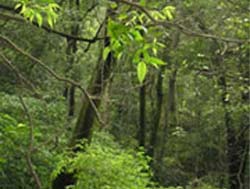
Old-growth forests are traditionally negligible as carbon sinks, but CAS scientists recently reported that the buildup of atmospheric carbon in the top-soils of 400-year-old forests in southern China have increased at an unexpectedly high rate up to nearly 68% from 1979 to 2003.
According to classic ecological theories, the carbon accumulation capability of established forests is insignificant because carbon uptake was thought to be balanced by respiration. However, after a continuous observation of the carbon stock dynamics over the past 25 years at the Dinghushan Biosphere Reserve in south China's Guangdong Province, ZHOU Guoyi and his colleagues from the CAS South China Botanical Garden and the US Geological Survey have arrived at different conclusions, posing challenges to the prevailing belief.
As reported in the Dec. 1 issue of
Science, the researchers made statistical analyses on 230 composite soil samples, and surprisingly found that the carbon accumulated in the 20-cm-thick topsoil layer increased between 1979 and 2003 from about 1.4% to 2.35%, with an average rate of 0.61 ton per hectare per year.
The discovery has aroused close attentions of ecologists as well as wide interests from the media and global readers, since understanding the locations and driving forces of carbon sources and sinks is critical for the prediction and management of the global carbon cycle and ultimately the behavior of the Earth's climate system.
Although scientists are not yet clear how the increase occurred, they speculate that below-ground processes, such as altered geochemistry or microbe behavior, may be credited, and hence made suggestions on further studies of the complex responses and adaptation of belowground system to global environment change. The researchers also advocated for a new, non-equilibrium conceptual framework for soil carbon dynamics.
The world climate has posed grave challenges to human inhabitants ever since the beginning of industrialization and urbanization. The over-emission of carbon dioxide into the Earth's atmosphere has led to a series of environmental problems headed by global warming. Despite the importance of finding out the carbon sources, sinks and the circulation driving force, it remains a headache for researchers around the world to unveil the enormous "missing sink" hidden within the Earth's ecosystem.







